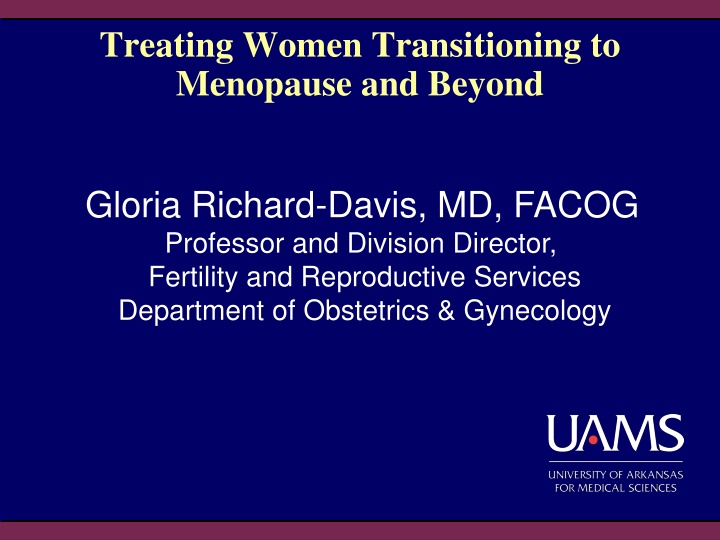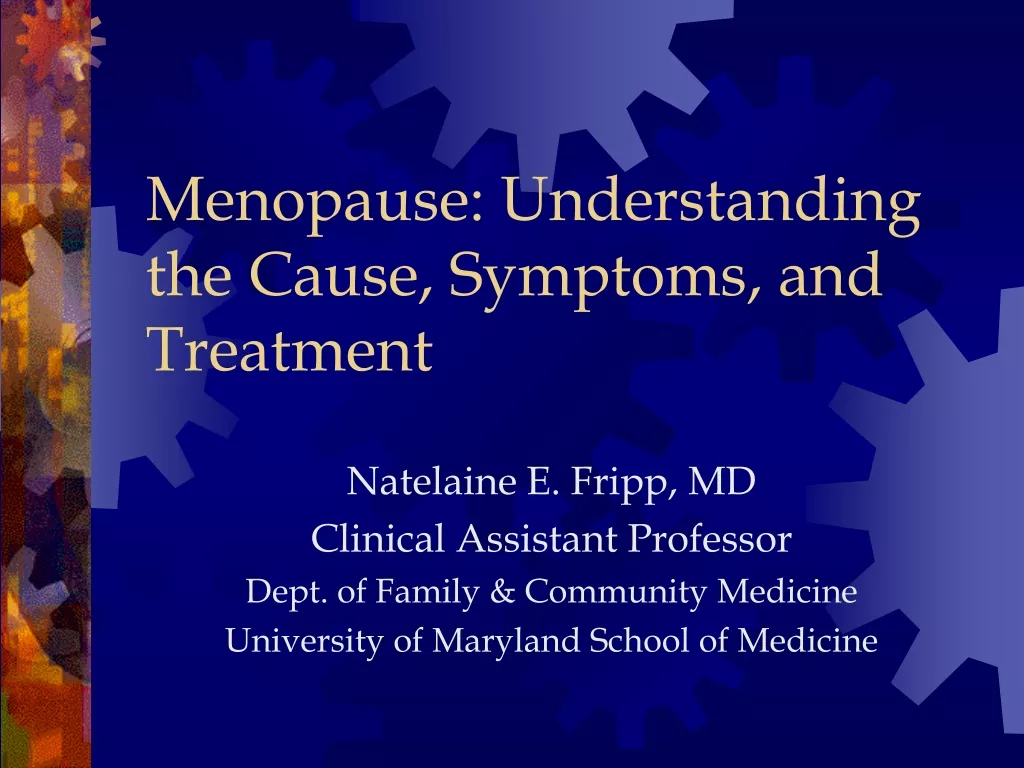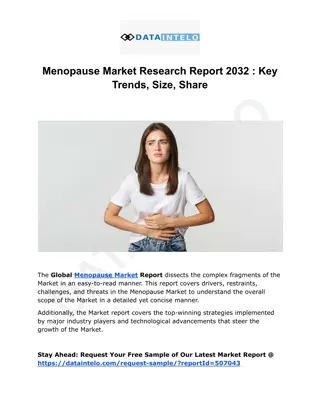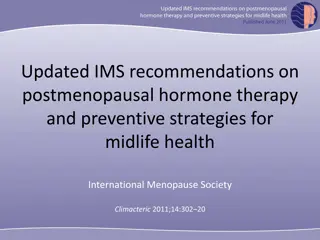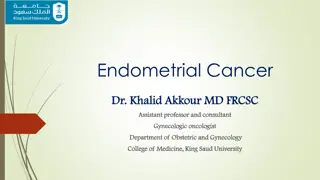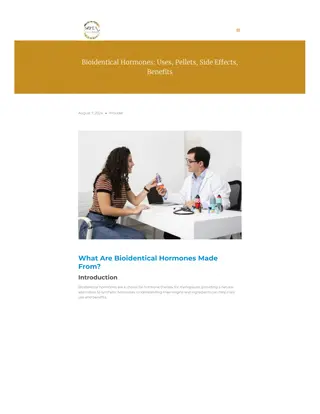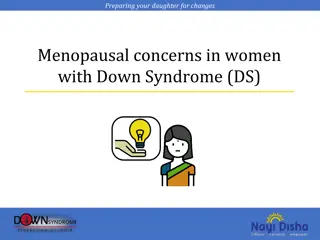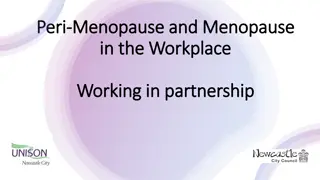Women Transitioning to Menopause: Clinical Management Insights
In this resource by Dr. Gloria Richard-Davis, delve into the clinical aspects of menopause, from defining perimenopause to discussing treatment options and resources for patients. Understand the impact of menopause on quality of life and learn how to manage menopausal symptoms effectively.
Download Presentation

Please find below an Image/Link to download the presentation.
The content on the website is provided AS IS for your information and personal use only. It may not be sold, licensed, or shared on other websites without obtaining consent from the author.If you encounter any issues during the download, it is possible that the publisher has removed the file from their server.
You are allowed to download the files provided on this website for personal or commercial use, subject to the condition that they are used lawfully. All files are the property of their respective owners.
The content on the website is provided AS IS for your information and personal use only. It may not be sold, licensed, or shared on other websites without obtaining consent from the author.
E N D
Presentation Transcript
Treating Women Transitioning to Menopause and Beyond Gloria Richard-Davis, MD, FACOG Professor and Division Director, Fertility and Reproductive Services Department of Obstetrics & Gynecology
Disclosure Pfizer Advisory Board and Consultant
Objectives - - To define perimenopause and menopause Discuss the clinical presentation of menopause and impact on quality of life Be able to manage treatment options for menopausal symptoms Identify resources to help patients and providers manage menopause - -
Menopause Management- Getting Clinical Care Back on Track -Over 50 million menopausal women by 2020 in US -2009 survey of IM resident revealed 75% feel uncomfortable treating menopausal women due to lack of training in residency -Ob Gyn residency also lacks sufficient training Manson & Kauntiz, NEJM 2016 374(9), 803
What is menopause? Menopause is a normal, natural event, defined as the final menstrual period (FMP), confirmed after 1 year of no menstrual bleeding Represents the permanent cessation of menses resulting from loss of ovarian follicular function, usually due to aging
When is menopause? Naturally (spontaneously) average age 51 Prematurely from medical intervention (eg, bilateral oophorectomy, chemotherapy) at any time from impaired ovarian function
Terminology: Postmenopause The years after the FMP resulting from natural (spontaneous) or premature menopause With current life expectancy, the postmenopausal years make up 1/3 to 1/2 of the lifespan of most North American women
Impact of Women on Health Care Women account for: 2 out of every 3 health care dollars spent (approximately $500 billion annually) Up to 90% of health care decisions 59% of all prescription drugs purchased 52% of US population In the future, health care providers will spend up to 75% of their time treating women aged 65 years and older. CareData Reports, Inc. 1999.
Age at Menopause Has Remained Constant While Life Expectancy Has Increased 80 60 Age (years) 40 20 0 1850 1900 1950 2000 Year Campbell S, ed. The Management of the Menopause and Postmenopausal Years. Baltimore, Md: University Park Press; 1976.
Menopause Demographics Approximately 4900 US women enter menopause each day.1 65+ 55-64 50-54 45-49 70 Number of US Women 2 60 50 (in millions) 40 30 20 10 0 1996 2000 2005* 2010* *Estimate. Year 1North American Menopause Society. 2US Bureau of the Census.
Ethnicity in the United States 100% Asian and Pacific Islander, Non-Hispanic 80% American Indian, Non- Hispanic 60% Hispanic 40% African American, Non-Hispanic 20% White, Non-Hispanic 0% 2000 2010 2050 US Census Bureau. Population Projections. Available at: http://www.census.gov/population/www/projections/popproj.html.
Life expectancy in years for U.S. Women by race/ethnicity, 2007 Race/ethnicity Years Black, non-Hispanic 76.9 Hispanic* 82.2 Asian/Pacific Islander 85.0 American Indian, Eskimo, Aleut 80.2 White, non-Hispanic 80.8 *Persons of Hispanic origin may be of any race. Source: Day, Jennifer Cheeseman. Population projections of the United States by age, sex, race, and Hispanic origin: 1995 to 2050, U.S. Bureau of the Census, Current Population Reports, P25-1130, U.S. Government Printing Office, Washington, DC, 1996. http://www.cdc.gov/nchs/data/hus/hus10.pdf#022 Health U.S. 2010
4 strategic steps for clinicians 1. Know cultural difference in menopause 2. Self awareness of CC 3. Adapt CC May Issue 2011 Features Providing culturally competent care for menopausal women Gloria Richard-Davis, MD, FACOG 4. Know resources available to help
Serum hormone levels at menopause Circulating estrogens Ratio of estrogen to androgen Sex hormone-binding globulin secretion Peripheral aromatization of DHEA to estrone Reversal of estradiol (E2) to estrone (E1) ratio No significant change in testosterone levels
Estrogen receptor activity Two estrogen receptors (ERs): ER- and ER- Both are present in the ovary, CNS & many other tissues Estrogen has many complex beneficial and deleterious effects on the body
Estrogen Loss and Manifestations of Health Risks Over Time Development of Subclinical Disease Short-Term Symptoms Long-Term Diseases Estrogen Secretion Hot flushes Mood, sleep, and/or acute cognitive changes Urogenital symptoms, skin changes Cardiovascular disease Osteoporosis Cognitive decline (Alzheimer s disease) 40 45 50 55 60 65 70 75+ Age (years)
MANAGEMENT OPTIONS FOR MENOPAUSAL SYMPTOMS
Why would perimenopausal women use hormonal contraception? Hormonal contraception offers a viable option for both symptomatic perimenopausal women and those who wish to avoid pregnancy Combination estrogen progestin contraceptives (pills, patch, ring) only appropriate for healthy, lean, nonsmoking perimenopausal women Contraindicated in women over age 35 who smoke Other potential contraindications include hypertension, diabetes, obesity, and other comorbidities
Noncontraceptive benefits of OCs Suppress vasomotor symptoms Restore predictable bleeding Decrease dysmenorrhea Enhance BMD Lower risk of endometrial and ovarian cancer
When to stop OCs Individualization is required Consider stopping in early 50s, typical age of menopause Can transition from OCs to HT if still symptomatic As low-dose OCs have higher hormone levels than HT, hot flashes may reappear transiently Kaunitz N Engl J Med 2008;358:1262-70
MENOPAUSAL HORMONE THERAPY
Terminology Estrogen therapy (ET): Unopposed estrogen is prescribed both a) systemically for women who do not have a uterus, and b) locally in very low doses for any woman with vaginal symptoms Estrogen-progestogen therapy (EPT): Progestogen is added to ET to protect women with a uterus against endometrial cancer, which can be caused by estrogen alone Bioidentical hormone therapy (BHT): Consists of hormones chemically identical or very similar to those made in the body. Available from two sources: 1) FDA- approved and tested; 2) unapproved and untested from compounding pharmacies
FDA-approved indications for HT All oral estrogens, most transdermal estrogen, and one vaginal estrogen are approved for moderate to severe vasomotor symptoms Some oral and transdermal products are approved for prevention of postmenopausal osteoporosis, but not for treatment
FDA-approved indications for vaginal HT Local vaginal estrogen is approved for atrophic vaginitis No vaginal product is approved for osteoporosis Two vaginal products are approved for dyspareunia as a symptom of vulvar and vaginal atrophy due to menopause One vaginal product is indicated for urinary urgency and dysuria
Black Box warning for HT Subsequent to the WHI trial in 2002, the US FDA and Health Canada require all estrogen- containing prescription therapies to carry a black box warning about the adverse HT risks which include cardiovascular disorders, endometrial cancer, breast cancer, and probable dementia Although only two products were studied in the WHI, all HT products including natural bioidentical and compounded hormones are assumed to have similar risks until proven otherwise
Hormone therapywhat we know today HT formulation, route of administration, and timing of initiation produce different effects (e.g. transdermal route may carry lower risk for thrombosis) Absolute risks for HT use in healthy women ages 50-59 are low, but can include thrombosis, stroke, and cardiovascular events HT initiation in older women carries greater risks Breast cancer risk increases with EPT beyond 3-5 years ET can be considered for longer duration of use because it carries a lower risk for breast cancer Consider each woman s priorities and risk factors prior to initiating HT
Menopause Management Getting Clinical Care Back on Track JoAnn E. Manson, M.D., Dr.P.H., and Andrew M. Kaunitz, M.D. N ENGL J MED 374;9 NEJM.ORG March 3, 2016
FIG. 1. US reported MHT use by formulation, January 2000 through December 2009, IMS Health, National Disease and Therapeutic Index. MHT, menopausal hormone therapy; WHI, Women s Health Initiative; E; estrogen; P, progestogen; ET, estrogen therapy; EPT, estrogen + progestogen therapy. Menopause, Vol. 18, No. 4, 2011 The North American Menopause Society
Vaginal Estrogen Use FIG. 4. US vaginal MHT use by age group, January 2001 through December 2009, IMS Health, National Disease and Therapeutic Index. MHT, menopausal hormone therapy. Menopause, Vol. 18, No. 4, 2011 NAMS
Table X. Estrogen therapy products approved for postmenopausal use in the United States Oral products Composition Product name(s) Range of available dose strengths Conjugated estrogens Synthetic conjugated estrogens, A* Synthetic conjugated estrogens, B** Esterified estrogens 17 -estradiol Estradiol acetate Estropipate Premarin Cenestin Enjuvia Menest Estrace, various generics Femtrace Ortho-Est 0.3-1.25 mg 0.3-1.25 mg 0.3-1.25 mg 0.3-1.25 mg 0.5-2.0 mg 0.45-1.8 mg 0.625 mg (0.75 mg estropipate, calculated as sodium estrone sulfate 0.625 mg) to 5.0 mg (6.0 mg) Transdermal products Composition Product name(s) Dose details 17 -estradiol matrix patch Alora, Climara, Esclim, Fempatch, Menostar, Vivelle, Vivelle-Dot, various generics 0.014-0.1 mg delivered daily; applied once or twice weekly 17 -estradiol reservoir patch Estraderm 0.05-0.1 mg delivered daily; applied twice weekly Applied daily via metered pump or packet delivering 0.52-0.75 mg of 17 -estradiol in gel 2 packets applied daily 17 -estradiol transdermal gel EstroGel, Elestrin, Divigel 17 -estradiol topical emulsion Estrasorb 17 -estradiol transdermal spray Evamist 1 spray/d, up to 2-3/d if needed * 9 estrogens ** 10 estrogens
Table X. Estrogen therapy products approved for postmenopausal use in US (contd) Vaginal products Composition Product name(s) Dose details 17 -estradiol vaginal cream* Estrace Vaginal Cream Initially 2-4 g/d for 1-2 wk, followed by maintenance dose of 1 g/d (0.1 mg active ingredient/g) Conjugated estrogens cream* Premarin Vaginal Cream For vaginal atrophy: 0.5-2 g/d for 21 d then off 7 d For dyspareunia: 0.5 g/d for 21 d then off 7 d , or twice weekly (0.625 mg active ingredient/g) 17 -estradiol vaginal ring Estring Device containing 2 mg releases 7.5 g/d for 90 days (for vulvovaginal atrophy) Estradiol acetate vaginal ring Femring Device containing 12.4 mg or 24. 8 mg estradiol acetate releases 0.05 mg/d or 0.10 mg/d estradiol for 90 days (both doses release systemic levels for treatment of vulvovaginal atrophy and vasomotor symptoms) Initially 1 tablet/d for 2 wk, followed by 1 tablet twice weekly (tablet 10 g of estradiol hemihydrates, equivalent to 10 g of estradiol; for vulvovaginal atrophy) Estradiol hemihydrate vaginal tablet Vagifem *N.B. Higher doses of vaginal estrogen are systemic, meant to relieve hot flashes as well as vaginal atrophy; the lower doses are intended for vaginal symptoms only even though a small amount does get absorbed.
Table XX. Combination EPT products comparing estrogen and progestogen doses Product name(s) Standard/low dose Estrogen Progestogen 2.5 or 5 mg medroxyprogesterone acetate Prempro Standard 0.625 mg conjugated estrogens Low 0.3 or 0.45 conjugated estrogens 1.5 mg medroxyprogesterone acetate 1 mg norethindrone acetate 5 g ethinyl estradiol Femhrt Standard 0.5 mg norethindrone acetate 2.5 g ethinyl estradiol Low 1 mg 17 -estradiol 0.5 mg norethindrone acetate Activella Standard 0.5 mg 17 -estradiol 0.1 mg norethindrone acetate Low 0.5 mg 17 -estradiol 1 mg drospirenone Angeliq Low 0.25 mg 17 -estradiol 0.5 mg drospirenone Lower
EPT & breast cancer Diagnosis of breast cancer increases with EPT use beyond 3-5 years Unclear whether EPT risk differs between continuous and sequential progestogen EPT and to a lesser extent ET increase breast cell proliferation, breast pain, mammographic density, repeat mammograms, and breast biopsies EPT may impede diagnostic interpretation of mammograms Increased breast cancer diagnosis declined 3 years post EPT cessation NAMS Menopause 2012;19:257-71
EPT & breast cancer (continued) Breast cancer mortality was higher in women assigned to EPT than in those assigned to placebo Women starting EPT shortly after menopause experienced increased breast cancer risk, but those with a gap time greater than 5 years did not NAMS Menopause 2012;19:257-71
ET & breast cancer ET arm of the WHI showed no increased cancer risk after mean 7.1 years on study There was a significantly decreased risk of breast cancer after 7.1 years, which persisted after discontinuation ET and EPT use in breast cancer survivors may increase recurrence risk Stefanick ML JAMA 2006;295:1647-57; NAMS Menopause 2012;19:257-71
HT & premature menopause/POI Data regarding HT in women over age 50 should not be extrapolated to younger postmenopausal women Likely that risks attributable to HT are smaller and benefits greater in these younger women Use of HT or oral contraceptives until median age of menopause is recommended, at which time decision can be reevaluated NAMS Menopause 2012;19:257-71
Progestogen indication Primary menopause-related indication for protestogen use is endometrial protection from systemic ET Adequate progestogen recommended for women with an intact uterus using systemic ET Progestogen generally not indicated with low-dose local ET for vaginal atrophy NAMS Menopause 2012;19:257-71
Bioidentical hormones Many well-tested, government-approved HT products contain bioidentical hormones Usually refers to compounded formulations Compounded preparations and salivary hormone testing not recommended Compounded HT not tested for efficacy, safety, batch standardization, or purity Some compounders make unsubstantiated claims about safety and effectiveness Compounded HT should include patient information NAMS Menopause 2012;19:257-71
Duration of use With EPT, increased risk of breast cancer incidence and mortality with 3-5 years of use With ET, no increase of breast cancer with early postmenopausal use; a decrease was found after hiatus in estrogen exposure With ET, potential CAD and CHD benefits with early use Initial increase in CHD risk when EPT is initiated further from menopause NAMS Menopause 2012;19:257-71
Duration of use (continued) Extending EPT use is acceptable for: Women who request it and are aware of its risks Prevention of osteoporosis for women at high risk of osteoporotic fracture when alternate therapies are not appropriate NAMS Menopause 2012;19:257-71
Discontinuation 3 years after EPT discontinuation: Rate of CVD, fractures, and colon cancer same as placebo Increase in all cancers and mortality from breast cancer 3 years after ET discontinuation: No increase in CHD, DVT, stroke, hip fracture, colorectal cancer, or total mortality Decrease in breast cancer persisted Heiss G JAMA 2008;299:1036-45; LaCroix AZ JAMA 2011;305:1305-14
Discontinuation (continued) HRs for all-cause mortality neutral for ET and EPT 50% chance of vasomotor symptoms recurring Symptom recurrence similar whether tapered or abrupt Decision to continue HT should be individualized NAMS Menopause 2012;19:257-71
HT summary HT formulation, route of administration, and timing of initiation produce different effects Individual benefit-risk profiles are essential Absolute risks in healthy women ages 50-59 are low Long-term use or HT initiation in older women, however, has greater risks Breast cancer risk increases with EPT beyond 3-5 years ET can be considered for longer duration of use due to its more favorable safety profile NAMS Menopause 2012;19:257-71
Screening tests for women ages 50-64 Test Blood pressure How Often At least every 2 years if normal (below 120/80) Bone mineral density Discuss with healthcare provider if at risk Cholesterol Regularly if at risk for heart disease Colonoscopy, fecal occult blood test, or sigmoidoscopy Beginning at age 50 Fasting blood glucose Regularly if overweight with additional risk factors Mammogram Every 2 years at age 50 Pap test Every 3 years or every 5 years if combined with HPV test Pelvic exam Yearly Sexually transmitted infection Both partners, including HIV, before initiating sexual intercourse Adapted from U.S. Dept. of Health and Human Services Office on Women s Health www.womenshealth.gov. Accessed 8/27/12
How women view menopause Midlife women do not consider menopause a time of health complaints, increased disease risk or a time for medical care, but rather a normal developmental phase 51% in early postmenopause said they were happier and more fulfilled than in their 20s, 30s, or 40s About 75% of women surveyed reported making some kind of lifestyle change at menopause Women with negative attitudes toward menopause report more menopausal symptoms Ayers Maturitas 2010;65:28-36; Woods Menopause 1999;6:167-73; NAMS Menopause 1999;5:197-202; NAMS Menopause 1999;6:122-8
